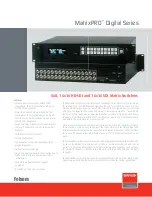
9
Master election
Master election is held each time the topology changes, for example, when the IRF fabric is established,
a new member switch is plugged in, the master switch fails or is removed, or the partitioned IRF fabrics
merge.
The master is elected based on the following rules in descending order:
•
The current master, even if a new member has a higher priority. (When an IRF fabric is being formed,
all member switches consider themselves as the master, and this rule is skipped)
•
The switch with higher priority.
•
The switch with the longest system up-time. (The member switches exchange system up-time in the
IRF hello packets.)
•
The switch with the lowest bridge MAC address.
The IRF fabric is formed on election of the master.
NOTE:
•
During an IRF merge, the switches of the IRF fabric that fails the master election must reboot to re-join the
IRF fabric that wins the election. The reboot can be automatically performed or must be manually
performed depends on the switch model.
•
After a master election, all slave member switches initialize and reboot with the configuration on the
master, and their original configuration, even if has been saved, will be lost.
IRF fabric management and maintenance
After the IRF fabric is established, you can access the master from any member switch to manage all the
resources of the member switches.
Member ID
An IRF fabric uses member IDs to uniquely identify and manage its members. Member IDs are used in
interface numbering and file management:
•
In interface numbering—Assume an interface on the switch that operates in standalone mode was
named GigabitEthernet 3/0/1. After the switch joined an IRF fabric, it receives a member ID of 2,
and the name of the interface changes to GigabitEthernet 2/3/0/1.
•
In file management
—When the switch operates in standalone mode, the path of a file is, for
example, slot1#flash:/. After the switch joins an IRF fabric, the path changes to
chassis
A
#slot1#flash:/, where A indicates the member ID of the switch in the fabric.
To guarantee the operation of the IRF fabric, you must assign each member switch a unique member ID.
NOTE:
If the active MPU and standby MPU of a member switch keep different member IDs of the switch, the
member ID kept by the active MPU is applied when the switch starts up. If the switch with the member ID
of 2 has only one active MPU, after you plug in a standby MPU that keeps a member ID of 3, the member
ID of the switch is still 2 and the member ID kept on the standby MPU is synchronized to 2.
IRF fabric topology maintenance
As soon as a member switch is down or an IRF link is down, its neighbor switches broadcast the leaving
of the switch to other members. When a member switch receives the leave message, it looks up its IRF














































